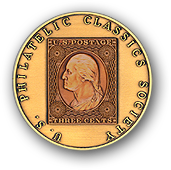
The 2¢ stamp was issued on March 19, 1869. It is primarily used on carrier rate covers or 2¢ drop plus carrier letters sent within New York City, as one such city, or on circulars of which 2¢ was the rate. The 2¢ was bisected which allowed the sender to use half of a 2¢ stamp to pay the 1¢ rate, or one-and-a-half 2¢ stamps to pay the 3¢ standard domestic rate in effect in 1869. The 2¢ stamp is also used to make up rates to foreign countries, most often as three 2¢ stamps to Canada and England for the 6¢ rate. Usage of the 2¢ stamps are also found to make up parts of rates to various foreign countries including Japan, Hong Kong, Peru and Italy.

Hoigo, Japan cancel

2c Bisect on cover

A rare large multiple of the 2c

Two essay’s showing unadopted designs for the 2c (Scott 113 E1 & E2)

A plate proof of the 2c (Scott 113 P2)

The earliest known use of the 2¢, a cover cancelled on March 19th, 1869

The 2¢ design features a post horse. Riding the post horse is a post rider or postal carrier, he carried a leather satchel that contained mail and small packages. His role was to collect and deliver mail sometimes exchanging mail with other post riders. Post riders would form a network of pre-arranged meeting points to exchange mail thus forming a cheap and speedy method of delivering correspondence. The engraving above and the engraving used in the design shows the horse with its legs outstretched, this was the common method of the time of illustrating a galloping horse. The post riders demise was the locomotive. To learn more about post riders click here.

Post Rider Blowing Horn on Scott #1478
It was not until 1973, over one hundred years later that a Post Rider again featured on a stamp. It was on a Bicentennial stamp (Scott #1478) that depicted a post rider blowing a horn, this was a common method of alerting town residents that the mail was arriving or departing.


